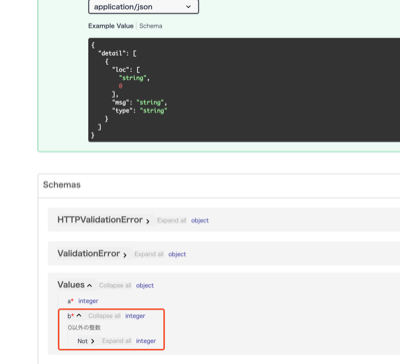APIのテストデータを自動生成できるSchemathesisの紹介
PyCon mini 東海 2025資料
 This work is licensed under a
Creative Commons Attribution 4.0 International License
.
This work is licensed under a
Creative Commons Attribution 4.0 International License
.
はじめに
自己紹介
-
Ryuji Tsutsui@ryu22e
-
さくらインターネット株式会社所属
-
Python歴は14年くらい(主にDjango)
-
Python Boot Camp、Shonan.py、GCPUG Shonanなどコミュニティ活動もしています
-
著書(共著):『Python実践レシピ』
今日話すこと
-
Schemathesisの概要
-
Schemathesisの使い方
-
Django + Schemathesisの例
今日話さないこと
-
Pythonの文法
-
pytestを使ったユニットテストの書き方
このトークの対象者
-
Pythonのユニットテストを書いたことがある人
このトークで得られること
-
Schemathesisの概要、使い方
-
Hypothesisの概要
-
「プロパティベーステスト」の概要
-
Schemathesisがどのような場面で役立つのか
トークの構成
-
Schemathesisの概要
-
Hypothesisの概要
-
コード例紹介
Schemathesisの概要
Schemathesisとは何か
Schemathesisとは、OpenAPIまたはGraphQLで書かれたAPI仕様を元にテストデータを自動生成し、実際にそれらのテストデータを使ってAPIを呼び出すことで、仕様通りの挙動になっているか検証できるツール。
どんなとき役立つか
-
人間が書いたテストコードでは気付けないエッジケースを見つけられる
-
仕様書と実装の乖離に気づくことができる
Schemathesisの簡単な使い方
使い方は2通り:
-
pytest経由で使う
-
コマンドラインインターフェースで使う
テスト対象のアプリケーション
以下のFastAPIアプリケーションを用意する。
import fastapi
from pydantic import BaseModel, StrictInt
app = fastapi.FastAPI()
class Values(BaseModel):
a: StrictInt
b: StrictInt
@app.post("/div")
async def div(values: Values):
"""2つの整数を受け取り、その商を返すAPIエンドポイント"""
# 0で除算するケースを考慮していないのは「バグ」。
return {"result": values.a / values.b}テストコード
import schemathesis
# (1)OpenAPI仕様書のURLを指定してスキーマを生成
schema = schemathesis.openapi.from_url("http://127.0.0.1:8000/openapi.json")
# (2)スキーマと戦略の定義に基づいてテストケースを生成
@schema.parametrize()
def test_api(case):
"""pytestでAPIのテストを実行する関数"""
# (3)Schemathesisが生成したテストケースを使用してAPIを呼び出し、
# 検証を行う
case.call_and_validate()テスト実行結果
$ pytest test_main.py -v
============================= test session starts ==============================
(省略)
test_main.py::test_api[POST /div] FAILED [100%]
=================================== FAILURES ===================================
_____________________________ test_api[POST /div] ______________________________
+ Exception Group Traceback (most recent call last):
(省略)
| - Server error
|
| - Undocumented HTTP status code
|
| Received: 500
| Documented: 200, 422
|
| [500] Internal Server Error:
|
| `Internal Server Error`
|
| Reproduce with:
|
| curl -X POST -H 'Content-Type: application/json' -d '{"a": 0, "b": 0}' http://127.0.0.1:8000/div
|
| (2 sub-exceptions)
+-+---------------- 1 ----------------
| schemathesis.core.failures.ServerError: Server error
+---------------- 2 ----------------
| schemathesis.openapi.checks.UndefinedStatusCode: Undocumented HTTP status code
|
| Received: 500
| Documented: 200, 422
+------------------------------------
=========================== short test summary info ============================
FAILED test_main.py::test_api[POST /div]
============================== 1 failed in 0.38s ===============================なぜエラーになるのか

a, bは整数なら何でも受け付ける仕様になっている
アプリケーションを修正
bが0のときバリデーションエラーになるよう修正。
import fastapi
from pydantic import BaseModel, Field, StrictInt, field_validator # (1)Field, field_validatorをインポート
app = fastapi.FastAPI()
class Values(BaseModel):
a: StrictInt
# (2)Fieldを使用してOpenAPIの拡張を追加
b: StrictInt = Field(
...,
description="0以外の整数",
json_schema_extra={
"not": {"const": 0} # OpenAPI拡張:b != 0 の意味
}
)
# (3)このメソッドを追加
@field_validator("b")
@classmethod
def b_must_not_be_zero(cls, v: int) -> int:
if v == 0:
# ここで ValueError を出しておくと FastAPI が 422 にしてくれる
raise ValueError("b must not be 0")
@app.post("/div")
async def div(values: Values):
"""2つの整数を受け取り、その商を返すAPIエンドポイント"""
return {"result": values.a / values.b}修正後のOpenAPIスキーマの内容

bは0を受け付けない仕様になった
修正後のテスト実行結果
$ pytest test_main.py -v
================================================================== test session starts ==================================================================
platform darwin -- Python 3.13.9, pytest-8.4.2, pluggy-1.6.0 -- /Users/ryu22e/development/temp/schemathesis-example/.direnv/python-venv-3.13.9/bin/python3.13
cachedir: .pytest_cache
hypothesis profile 'default'
rootdir: /Users/ryu22e/development/temp/schemathesis-example
plugins: schemathesis-4.4.3, hypothesis-6.142.1, anyio-4.11.0, subtests-0.14.2
collected 1 item
test_main.py::test_api[POST /div] PASSED [100%]
=================================================================== 1 passed in 1.02s ===================================================================コマンドラインインターフェースを使う方法
schemathesisまたはstコマンドを使う。
$ schemathesis run http://127.0.0.1:8000/openapi.json
Schemathesis dev
━━━━━━━━━━━━━━━━
✅ Loaded specification from http://127.0.0.1:8000/openapi.json (in 0.10s)
Base URL: http://127.0.0.1:8000/
Specification: Open API 3.1.0
Operations: 1 selected / 1 total
✅ API capabilities:
Supports NULL byte in headers: ✘
⏭ Examples (in 0.11s)
⏭ 1 skipped
✅ Coverage (in 0.40s)
✅ 1 passed
✅ Fuzzing (in 0.68s)
✅ 1 passed
===================================================================== SUMMARY ======================================================================
API Operations:
Selected: 1/1
Tested: 1
Test Phases:
✅ API probing
⏭ Examples
✅ Coverage
✅ Fuzzing
⏭ Stateful (not applicable)
Test cases:
128 generated, 128 passed
Seed: 25425465587409846911775882801013537899
============================================================= No issues found in 1.20s =============================================================SchemathesisはPythonで書かれていないアプリケーションにも使える
-
結局、スキーマ定義を元にHTTPで通信しているだけ
-
テスト対象がどんな言語で書かれていても関係ない
-
ただし、WSGIまたはASGIで通信する方法もあって、こちらのほうが高速
WSGIまたはASGIで通信する場合の書き方
import schemathesis
from main import app # (1)FastAPIアプリケーションをインポート
# (2)from_asgi関数にOpenAPI仕様書のパスとアプリケーションを渡す
# またはschemathesis.openapi.from_wsgi()を使う
schema = schemathesis.openapi.from_asgi("/openapi.json", app)
... # 省略別のバグを仕込んでみる
... # 省略
@app.post("/div")
async def div(values: Values):
"""2つの整数を受け取り、その商を返すAPIエンドポイント"""
assert values.a < 1000000 # 大きな値を受け取ると発生するバグ
return {"result": values.a / values.b}テスト完了までかかる時間
$ time pytest test_main.py -v
(省略)
================================================================ short test summary info ================================================================
FAILED test_main.py::test_api[POST /div]
=================================================================== 1 failed in 1.45s ===================================================================
pytest test_main.py -v 1.45s user 0.15s system 81% cpu 1.975 totalテストを再実行してみる
前回より終了時間が短い。
$ time pytest test_main.py -v
(省略)
================================================================ short test summary info ================================================================
FAILED test_main.py::test_api[POST /div]
=================================================================== 1 failed in 0.34s ===================================================================
pytest test_main.py -v 0.56s user 0.10s system 78% cpu 0.843 totalなぜ2回目は早く終わるのか?
-
Schemathesisは前回エラーになったテストデータをキャッシュしている
-
2回目以降はキャッシュを元に、エラーになりそうなデータを優先的に実行する
キャッシュの場所
$ ls -1A [~/development/temp/schemathesis-example]
__pycache__
.hypothesis # これがキャッシュ
.pytest_cache
main.py
test_main.pyなぜ「.hypothesis」?
なぜ「.schemathesis」じゃないの?
→答えは次のセクションで
Hypothesisの概要
Hypothesisとは何か
-
Hypothesisの読み=ハイポセシス
-
Schemathesisが内部で利用しているテストフレームワーク
-
「プロパティベーステスト」というテスト手法でテストできる
「プロパティベーステスト」がどのような考え方のテスト手法なのか
-
従来のテストコード:
-
人間が「入力値」「期待する返却値」を考える
-
-
プロパティベーステスト:
-
人間が「入力に対するコードの振る舞い」(プロパティ)を考え、テストデータの生成はツールに任せる
-
プロパティベーステストの例
以下の関数のテストをやってみる。
def div(a, b):
return a / b従来のテストコードを書く場合
人間が「入力値」「期待する返却値」を考える。
import pytest
@pytest.mark.parametrize(
"a, b, expected",
[
(10, 2, 5),
(7, 2, 3.5),
(6, -3, -2),
(123.456, 1, 123.456),
],
)
def test_div(a, b, expected):
"""通常の除算が期待通りに動作するかを確認"""
assert div(a, b) == expectedプロパティベーステストの場合
import pytest
from hypothesis import given, strategies as st
@given(a=st.floats(allow_infinity=False, allow_nan=False),
b=st.floats(allow_infinity=False, allow_nan=False))
def test_div_basic_property(a, b):
result = div(a, b)
# 浮動小数誤差を考慮して、a ≈ result * b が成り立つ
assert pytest.approx(a, rel=1e-9, abs=1e-9) == result * b「プロパティベーステスト」についての参考図書
「プロパティベーステスト」は難しい、が……
SchemathesisはOpenAPIやGraphQLのスキーマを読ませるだけで使えるので簡単。
コード例紹介
Django(+ Django REST framework)製のAPIとSchemathesisを組み合わせてみる。
Djangoアプリケーションを用意する
以下のライブラリを使用。
-
Django REST framework
-
drf-spectacular(OpenAPIスキーマを生成する)
-
pytest
-
pytest-django
-
schemathesis
WSGIまたはASGIで通信する場合
import pytest
# または from example.asgi import application as app
from example.wsgi import application as app
@pytest.fixture
def web_app(db):
"""DjangoアプリケーションのWebアプリケーションを返す"""
# ASGIオブジェクトならfrom_asgi()関数を使う
return schemathesis.openapi.from_wsgi("/api/schema.json", app)
# from_pytest_fixture()関数に上記の関数名を指定
schema = schemathesis.pytest.from_fixture("web_app")pytestを実行してみると……
$ pytest
(省略)
| - Undocumented HTTP status code
|
| Received: 400
| Documented: 200
|
| [401] Unauthorized:
|
| `{"detail":"Invalid username/password."}`
|
| Reproduce with:
|
| curl -X GET -H 'Content-Type: application/json' -d 0 --insecure http://localhost/books/
|
| (1 sub-exception)
+-+---------------- 1 ----------------
| schemathesis.openapi.checks.UndefinedStatusCode: Undocumented HTTP status code
|
| Received: 401
| Documented: 200
+------------------------------------なぜテストが通らないのか?
drf-spectacularが生成したOpenAPIスキーマのせい。

スキーマ上はどんなリクエストも200を返す仕様になっている
drf-spectacularの何が問題か
-
drf-spectacularは異常終了を考慮しない
-
SchemathesisはOpenAPIスキーマが絶対正しいという前提
-
「そうか、どんな入力値でも絶対に200 OKなんだな!」と考える
-
でも、実際にはそうではないのでコケる
どうすればいいか
drf-standardized-errorsを導入する。
「それで、結局Schemathesisがあれば人間はテストコードを書かなくてもよくなるの?」
Schemathesisはテストコードを自動生成してくれる。 つまり、人間がテストコードを書かなくてもテストが機能するのでは?
結論から言うと
そんなことはない😇
Schemathesisのテストの問題点
-
どんなテストが実行されるのかコントロールできない
-
テストコードからアプリケーションの仕様を読み取れなくなる
Schemathesisの使い所
テストコードは従来通り書きつつ、最初に挙げた以下の2点の利点を活かすのが良い。
-
人間が書いたテストコードでは気付けないエッジケースを見つけられる
-
仕様書と実装の乖離に気づくことができる
最後に
まとめ
-
schemathesisはOpenAPIまたはGraphQLスキーマを元にテストを行ってくれる
-
人間が気づかないエッジケースを見つけてくれる
-
ただし、従来のテストコードは書いて補助的に使うのがよさそう
ご清聴ありがとうございました

schemathesisで高品質のAPIを開発する有能エンジニアたち